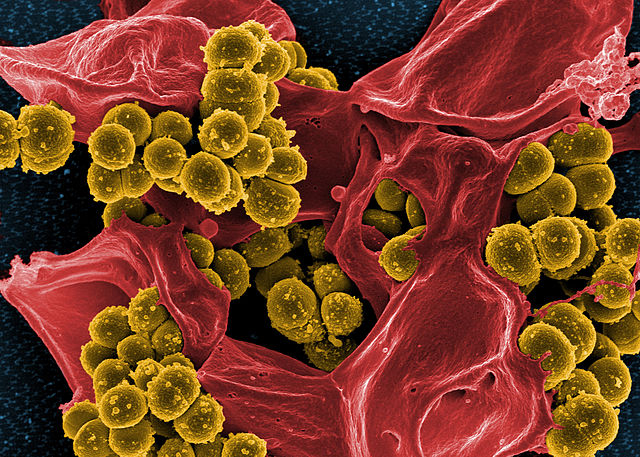Case of Mistaken Identity Leads to Much-Needed Drug Target Against MRSA, Gram-Positive Infections

by NIAID_Flickr. Licensed under CC BY 2.0 via Wikimedia Commons – Scanning electron micrograph of Methicillin-resistant Staphylococcus aureus (MRSA) and a dead Human neutrophil
Scientists at the University of Utah and the University of Georgia have uncovered a pharmacological target that could enable development of novel drugs against antibiotic-resistant pathogens, including Methicillin-resistant Staphylococcus aureus (MRSA) and other infectious Gram-positive organisms such as Listeria and Mycobacterium tuberculosis.
The target was revealed upon discovery of a Gram-positive bacteria-specific pathway for making heme, an essential iron-carrying molecule. The findings were reported in the journal, Proceedings of the National Academy of Sciences (PNAS).
“The therapeutic target could be used to create a completely new class of drugs for fighting Gram-positive bacteria including those that cause antibiotic-resistant infections,” says John Phillips, Ph.D., senior author of the paper and research professor in hematology at the University of Utah School of Medicine.
The fortuitous discovery was an outcome of a quest to solve a case of mistaken identity. For the past 100 years, the prevailing notion was that every organism – from bacteria to man – used the same eight-step recipe to make the essential, snowflake-shaped iron transporter, heme.
That’s why Harry Dailey, Ph.D., first author and biochemistry professor at the University of Georgia, was puzzled when he noticed that proteins that were given the name HemN, a key component of the historically-defined heme pathway, looked very different in Gram-positive bacteria than in other classes of bacteria. The code of amino acids – building blocks of proteins – that were recorded as Gram-positive “HemN” didn’t match up with the rest.
“It made me wonder, ‘What do we know, as opposed to what do we think we know?’” recalled Harry Dailey, Ph.D., first author and professor of biochemistry at the University of Georgia.
In the lab, he found that the so-called Gram-positive bacteria “Heme N” was, in fact, incapable of making heme. Determined to figure out what substitutes for HemN, Dailey collaborated with Phillips to purify components of the heme pathway in Gram-positive bacteria.
Like figuring out how to make a cake by seeing how it looks after each step of the recipe is completed, they collected the intermediates of the heme pathway, and determined that the last three were completely different than expected. Biochemical experiments further showed that a Gram-positive specific enzyme called HemQ is required for the final step. A survey of heme pathway components in over 350 other organisms support the idea that only Gram-positive bacteria use the alternate, HemQ-dependent recipe for making heme.
The implications were immediately obvious to Dailey and Phillips. “A drug that disables HemQ, will knock out heme biosynthesis only in Gram-positive bacteria, sparing this important pathway in our own cells,” explains Dailey. He has already demonstrated that genetically eliminating HemQ severely disables the troublesome germs, suggesting a drug that targets the protein will do the same. If screens against existing compounds identify one that is capable of blocking HemQ, a drug could be available in as quickly as two years; development of a new antibiotic could take ten years.
“The original goal of this work was to sort out the naming of different bacterial genes, but the result was identifying a completely new metabolic pathway that can be exploited to improve healthcare,” says Phillips. “It’s a reminder that, to paraphrase Louis Pasteur, chance favors the prepared mind.”
The study was supported by the National Institutes of Health.
Co-authors include Tamara Dailey and Joseph Burch of the University of Georgia, and Svetlana Gerdes of the Argonne National Laboratory.
Noncanonical coproporphyrin-dependent bacterial heme biosynthesis pathway that does not use protoporphyrin. PNAS Early Edition, Feb. 2, 2015
Contact Information
Julie Kiefer
Communications Specialist
jkiefer@neuro.utah.edu
Phone: 801-597-4258
Media Contact
More Information:
http://unews.utah.edu/All latest news from the category: Life Sciences and Chemistry
Articles and reports from the Life Sciences and chemistry area deal with applied and basic research into modern biology, chemistry and human medicine.
Valuable information can be found on a range of life sciences fields including bacteriology, biochemistry, bionics, bioinformatics, biophysics, biotechnology, genetics, geobotany, human biology, marine biology, microbiology, molecular biology, cellular biology, zoology, bioinorganic chemistry, microchemistry and environmental chemistry.
Newest articles

A universal framework for spatial biology
SpatialData is a freely accessible tool to unify and integrate data from different omics technologies accounting for spatial information, which can provide holistic insights into health and disease. Biological processes…

How complex biological processes arise
A $20 million grant from the U.S. National Science Foundation (NSF) will support the establishment and operation of the National Synthesis Center for Emergence in the Molecular and Cellular Sciences (NCEMS) at…

Airborne single-photon lidar system achieves high-resolution 3D imaging
Compact, low-power system opens doors for photon-efficient drone and satellite-based environmental monitoring and mapping. Researchers have developed a compact and lightweight single-photon airborne lidar system that can acquire high-resolution 3D…





















